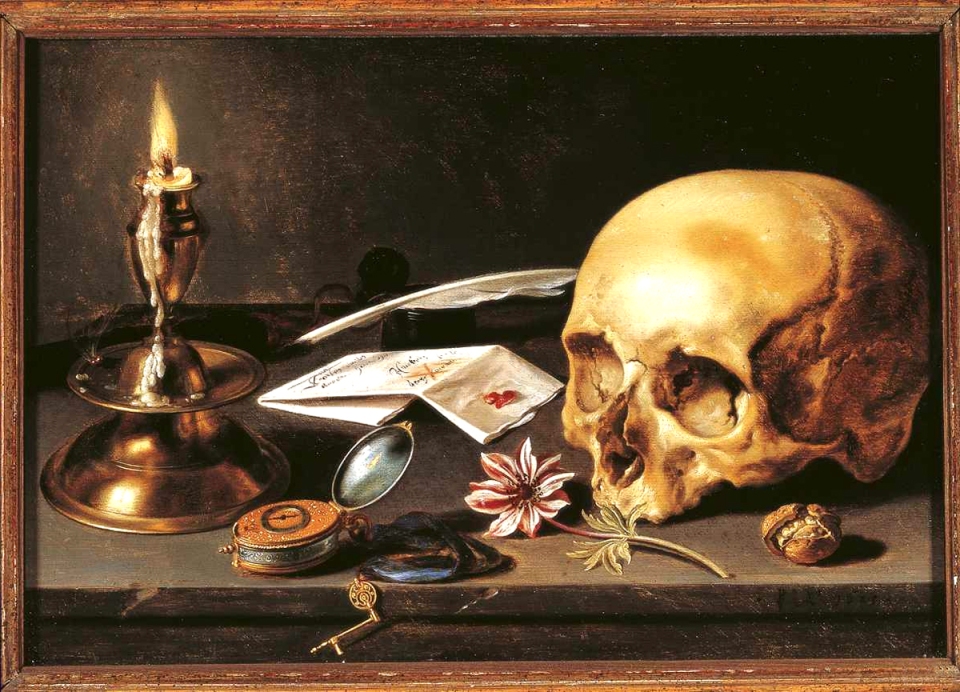Our recent trip to the National Gallery in London fuelled my research into these Vanitas paintings. Upon looking into some of the historical portraits I saw I came across an interesting fact; that in the 17th and 18th century portrait artists used to paint objects to keep their skill in whilst waiting for commissions.
More often than not they would represent their subject using a range of objects in a painting that resembles still life. These objects each held their own symbolism or range of meanings:
- Skull: Death, this is a clear memento mori message or the transience of life, a universally recognized symbol of death.
- Watch or hourglass: time is limited and is passing, therefore, use it wisely. See a typical one-handle XVII century watch at the lower right of the photo.
- Books: Human knowledge and its temporary nature.
- Artist’s instruments e.g. Palette, brushes, easel: Indulgence in the arts, very few could afford to be painters let alone patronize the arts.
- Shell: they were normally exotic ones not commonly available in the Netherlands. They were a symbol of the vanity that comes with wealth, as these were exotic items at the time, only a very wealthy person would have one of those.
- Insects, decaying flowers: transience of life. They were inserted in paintings depicting expensive objects as a reminder that life is temporary and moral considerations deserved more attention than material things.
- Broken or tipped over glassware: transience of life or life is fleeting.
- Musical instruments: indulgence of the senses as a luxury. Sometimes they are present as artistic inspiration, as music would inspire artists.
- Silk or velvet tablecloths: vanity, as these were expensive things. Silk being the ultimate fabric material and purple the most expensive dye, hence the Roman emperors wore purple tunics.
- Oriental rugs or carpets: These were prohibitively expensive items, carpets were placed on tables to avoid stepping on them and causing decay in their colors or integrity. They were a symbol of wealth but also a sign of pride as they were items brought into the United Provinces through trade and commerce.
- Jewelry, clothes or mirrors: remember the temporary nature of beauty, wealth and wisdom. Earthly riches are temporary and therefore life should be carried out according to the modesty traditions that were in place at the time.
- Mirror: a clear symbol of the vanity that should be avoided.
- Jars: Stoneware or porcelain were used for water or oil, both substance sustain life at the time.
(Sourced from http://levinrodriguez.blogspot.co.uk/2012/02/symbolic-meaning-of-objects-used-in.html)
The image above is one painted by Pieter Claesz in 1625 and from the information above we can begin to read the painting. Noting that the subject he was representing was both wealthy due to the compass which signifies that he was well travelled and the pen and paper which meant he could read and write. Something that at the time only the wealthy could do. The skull and the flower represents his mortality. The fact that we select objects upon which to place these narrative is what I am intrigued by. This notion was born in the 17th century and is still present today in the relationship we have with our affects.
This unique depiction of human life has defined people for centuries. And I can’t help but connect this historical technique to what I am exploring within this project for portraiture. Picking objects to show their representation of humans. Having the symbolism defined here is essential to the objects I select. Taking them out of context as the painter does is also something I want to be playful with.
Rodriguez, Levin. ‘..The Berkemeyer Project..: Symbolic Meaning Of Objects Used In Vanitas Paintings’. Levinrodriguez.blogspot.co.uk. N.p., 2012. Web. 18 Feb. 2015.
National Gallery, London, Visited 4th February 2015





